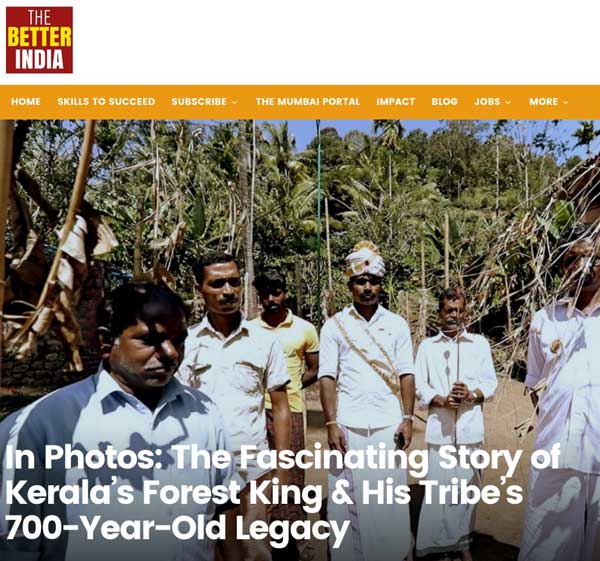Basil Poulose, The Better India, 13 April 2017 | To view a series of photos and read the full article, click here >>
Stories of kings, palaces and chariots from history books always manage capture our imagination. What if kings and kingdoms existed today? Deep in the forests of Idukki, a mountainous district in Kerala, there still lives a king and his subjects. The Mannan tribe, one of the 35 tribal communities in the state, follows time-honoured traditions, including a system of matrilineal kingship even today. […]
Raja Raman Mannan is the latest in a long line of kings who have reigned over the tribe and preserved the traditions and ecology of the region for centuries. According to the tribal leaders of the district, a ferociously fought war waged between the Pandya and Chola kingdoms 700 years ago. […]
Source: The Fascinating Story of Kerala’s Forest King & His Tribe’s 700-Year-Old Legacy
Address: http://www.thebetterindia.com/95726/kerala-forest-king-raja-raman-mannan-idukki/
Date Visited: Sun Apr 23 2017 13:10:52 GMT+0200 (CEST)
Ancient burial urn excavated in Idukki district
The Hindu, KATTAPPANA, December 30
The nannangady (burial urn) believed to be of megalithic era recently excavated from a construction site near Ramakkalmedu in Idukki district throw light on the possibility of carbon dating for further studies as there were bone remains found inside it. […]
Megalithic evidences like dolmens (muniyaras), table stones, burial urns and historic stones believed to be of BC 1050 and AD 300 was discovered at various locations in the eastern parts of the district. It is believed that an administrative hierarchy in Keezhmalanadu with a supporting civilisation existed in the interior areas of the present Thodupuzha spread over the Western Ghats. […]
The Idukki district administration has drawn up a project ‘Discovering Idukki,’ in its annual budget for 2011- ’12 to protect the megalithic sites and initiate studies into them. It also plans to open a megalithic museum at the district headquarters in Painavu for collection and preservation of the historical remains excavated in the district.
Source: Ancient burial urn excavated in Idukki district – The Hindu
Address: http://www.thehindu.com/news/national/kerala/Ancient-burial-urn-excavated-in-Idukki-district/article13447354.ece
Date Visited: Sun Apr 23 2017 13:32:20 GMT+0200 (CEST)
[Bold typeface added above for emphasis]

Dr. Ivy Hansdak clarifies that during the early twentieth century, “two main streams within Indian anthropology influenced the literary and visual representations of tribes by mainstream writers, artists and film-makers. One group was led by GS Ghurye (the assimilationist position) and the other by Verrier Elwin (the isolationist position). Later, Elwin shifted to the intergrationist position. According to the former, tribes were seen as ‘backward Hindus’ and an attempt was made to assimilate them into the Hindu fold. The identity of tribals as ‘vanavasi‘ comes from this position. Elwin, on the other hand, wanted to preserve their distinctive culture and often glorified them as the Noble Savage. Elwin’s views influenced Pandit Nehru’s tribal policy. Today, most tribals are being clubbed together with the scheduled castes (SC or dalit) with whom they share reservation in college admission and jobs. In the government documents, ‘SC/ST‘ are usually written together. The certificate that is issued to those claiming reserved status is also called ‘caste certificate’.” (email dated 26 April 2023)
